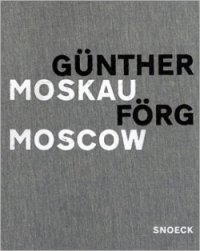Luhring Augustine Gallery, New York, New York

Günther Förg: Moscow
Günther Förg’s photos of Moscow are very, very beautiful. This comes as no surprise vis-a-vis Förg, but is really quite astonishing vis-a-vis Moscow. In a sort of frieze comprising 31 large black and white prints, Förg represents some of the great buildings constructed in that city during the idealist ’20s and ’30s. We’ve seen many tributes to the great utopia since the decay of the Soviet state liberated us to speak of this work with admiration, and without anxiety about its political implications, but fortunately this show moves beyond that paradigm.
The rather illiterate press release states that “Förg’s Moscow pictures serve as a narrative in the history of the Soviet Union from a time when the state was supportive of artistic endeavors until the current time of apathy toward culture and the state in Moscow.” But Forg’s photos have a radicalism far more profound than that, one that lies in their attractiveness. It is a cliche of our times that Modernism ages badly. Take a nice Elizabethan country house or a Victorian cottage or a Palladian villa and leave it alone for a century or two and what you’ll have is something even more exquisite than the original, utterly charming in its decay; but take something with the severe lines of the International style and with neglect it becomes absurd and depressing. Look at Brasilia. Alienating, miserable, and hideous. Indeed much of the cant of post-Modernism has been founded on a disavowal of architecture that cannot mellow with time. There is a certain authenticity to these arguments, but it is also the case that people who lived in past centuries would be horrified to see their buildings endearingly degenerate, and that part of our loathing for decayed Modernist work has to do with our lack of nostalgia for Modernism itself. Forg’s photos point the way to a future when the crumbling of those strong, clean lines of utopian idealism will seem beautiful and romantic. His huge photos, in soft focus, printed with dust in the negatives, give these buildings the sentimental haze that Turner brought to the early days of the railroad. The decay is of course palpable, and sad, but these images, though desolate, are not patronizing of Russia; in them, you see not so much a failed experiment as one that turned out otherwise than intended. There are human figures in only two photos; the rest are just buildings, the wires dangling on the face of the Russakov Club, the plaster breaking up on the Dukstroi Corporation Apartment Building, the haunting stairwells of the bus garages.
In the secondary gallery, there were two huge color photos of Constantine Melnikov’s studio. (Melnikov is one of the architects whose work appears in the first series). Though less evocative than the black and white work, they share its enormous formal accomplishment. Forg’s ability to capture the powerful symmetries of these buildings transcends any experience one might have of them from street level: his details are the perfect, beautiful, telling ones, his camera angles elegant and spectacular, his sense of light and texture profound. His juxtapositions of photos in the composition of his frieze is magnificent: lines continue from one into another to noble and coherent effect. These photos not only show what happened to the great utopia, they also give a glimpse of what will happen to it.











